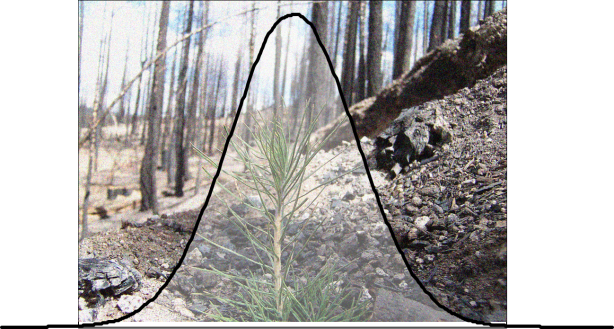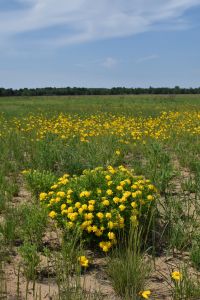Issue 54:4 of the Journal of Applied Ecology features a Special Feature, Toward prediction in the restoration of biodiversity. In this blog, the Guest Editor, Lars Brudvig introduces the work and the ecological ideas behind this collection of articles.
By repairing ecosystems damaged through human activities, ecological restoration plays an important role in biodiversity conservation efforts. Furthermore, restoration promotes functional ecosystems and the ecosystem services they provide to humans. Restoration projects span virtually every type of ecosystem on Earth, employ a variety of increasingly sophisticated approaches and range in scope from small, locally driven endeavors to global-scale initiatives like the Bonn Challenge (to restore hundreds of millions of hectares of forest).
Restoration is successful when pre-defined goals are met, such as the presence of a particular set of species. Yet, in practice, the outcomes of restoration are notoriously unpredictable. Why, when managers conduct similar restoration practices, like prescribed burning or tree planting, on seemingly similar sites, can the outcomes vary so widely? The August issue of Journal of Applied Ecologyexplores this question from the perspective of biodiversity, through a Special Feature, ‘Toward prediction in the restoration of biodiversity’. This Special Feature emerged from an Organized Oral Session at the 2015 Ecological Society of America Meeting, featuring talks by many of the Special Feature authors (read more here).

The Special Feature begins with an Editorial that outlines the scope and provides a summary of the Special Feature’s articles. The articles move beyond the common success vs. failure dichotomy in restoration to consider variation among restoration outcomes and the causes of this variation. To do this, they connect a variety of ecological theories and concepts to the practice of restoration. Many of these relate to how ecological communities develop, or assemble, over time, and articles explore how this assembly is affected by the traits (attributes) of species, the dispersal of seeds, interactions between plants and soil microbes, the order that species arrive to a location, and others. The articles consider biodiversity broadly, including through metrics that are commonly used in restoration, such as the richness (number) and composition (identities) of species. They also consider diversity metrics of emerging interest in the ecological literature but for which we currently know little about in restoration contexts (e.g., based on the attributes [traits] and evolutionary [phylogenetic] relationships among species). The articles grapple with these considerations through comparisons among existing restoration efforts, experiments to understand the importance of particular processes during restoration, and models to interpret variation and connect this variation to specific environmental conditions and restoration practices.
The result is a set of articles that embrace the interface of ecological theory and restoration practice, shed light on variation among restoration outcomes, and point the way toward predictive restoration science – a future where we might robustly explain the reasons for variation among restoration efforts and forecast the outcomes of restoration efforts before their initiation. An overview of the Special Feature’s articles includes:
A collaborative review article written by many of the Special Feature authors argues that the variation that we observe among restoration efforts is a consequence of when, where, and how restoration is practiced, as well as how the outcome of restoration is measured (e.g., habitat structure vs. species composition).

Jonathan Bauer and colleagues show how the performance of grassland plant species used in restoration is affected by site-to-site variation in soil microbes (e.g., mycorrhizae, bacteria) and ‘feedbacks’ between plants and soil microbes that develop over time. This has consequences for how plant communities develop – and differ among sites – over time during restoration.
Loralee Larios and colleagues explore the concept of resilience in restoration, showing that native grasslands are resilient to invasion at low, but not high, levels of eutrophication (nitrogen inputs). Their results inform how to prioritize limited restoration resources in a changing world.
Katie Stuble and colleagues illustrate how restoration trajectories depend on the location of and year in which restoration was initiated. Their results affirm the idiosyncratic nature of restoration outcomes, but show that this variation can be interpreted and related to measureable environmental conditions (e.g., planting year temperature and precipitation).
Daniel Laughlin and colleagues test and provide general support for an idea that we propose in our review article – that certain ecosystem properties will be intrinsically more predictable than others during restoration. They show that vegetation structure (biomass), species richness (number of species), and functional diversity (diversity measurement based on the traits of species) are relatively more predictable than community composition (identities of species).
Chad Zirbel and colleagues show the utility of plant functional traits (attributes of species, such as their height and seed mass) for interpreting variation among restoration efforts. Traits were important for understanding both the development of the plant community within a site and how the ecosystem functioned, including plant productivity and biomass decomposition.
Becky Barak and colleagues compare restored and remnant (high quality, reference site) grasslands based on different plant diversity metrics, showing similar numbers of species, but different species identities (community composition) and evolutionary relationships among species (phylogenetic diversity). To rectify these differences, they call for more phylogenetically diverse seed mixes in restoration. For example, in this study system, species from the Liliaceae and Orchidaceae families are often absent from restoration seed mixes (and from restored sites), but found in remnants.
Karen Holl and colleagues evaluate tree recruitment within a large scale tropical forest restoration experiment. They show that, over the course of a decade, tree recruitment has been affected by the local-scale tree planting regime but not the amount of forest in the surrounding landscape.
Nash Turley and colleagues show that the slow recovery of understory herbs onto former agricultural lands is due to limited seed dispersal and low rates of establishment for arriving seeds, due to dense plantation conditions. Restoration by seed sowing and tree thinning both increase rates of herb establishment.
All articles in the Special Feature, Toward prediction in the restoration of biodiversity, are available in issue 54:4 of the Journal of Applied Ecology.
Featured image: Longleaf pine savanna on former agricultural lands undergoing experimental restoration by canopy tree thinning and seed sowing. Image by Nash Turley.
Blog reposted with permission from: https://jappliedecologyblog.wordpress.com/2017/07/20/toward-prediction-overview


